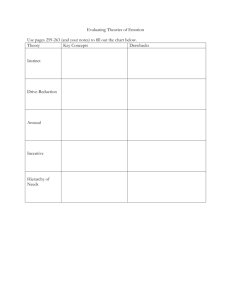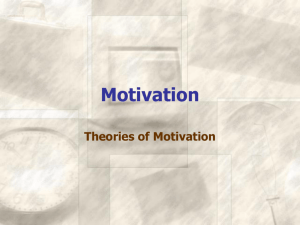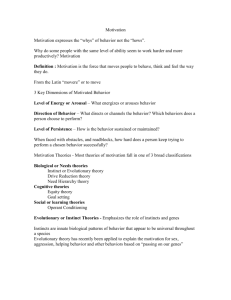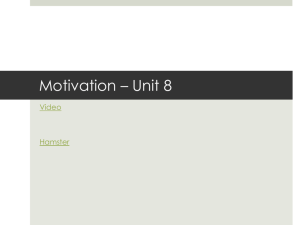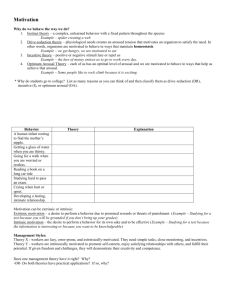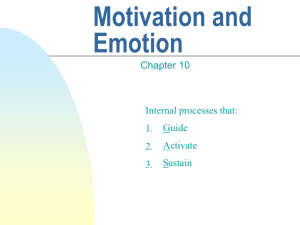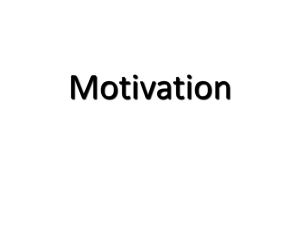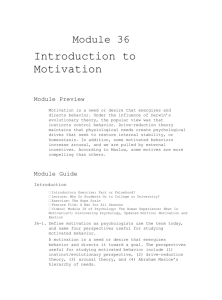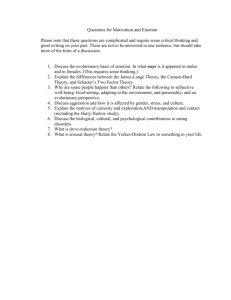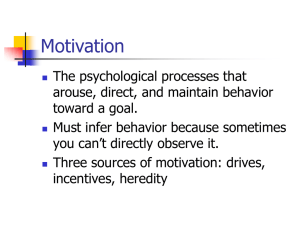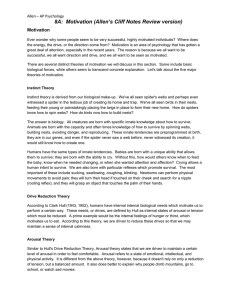Motivation and Emotion
advertisement
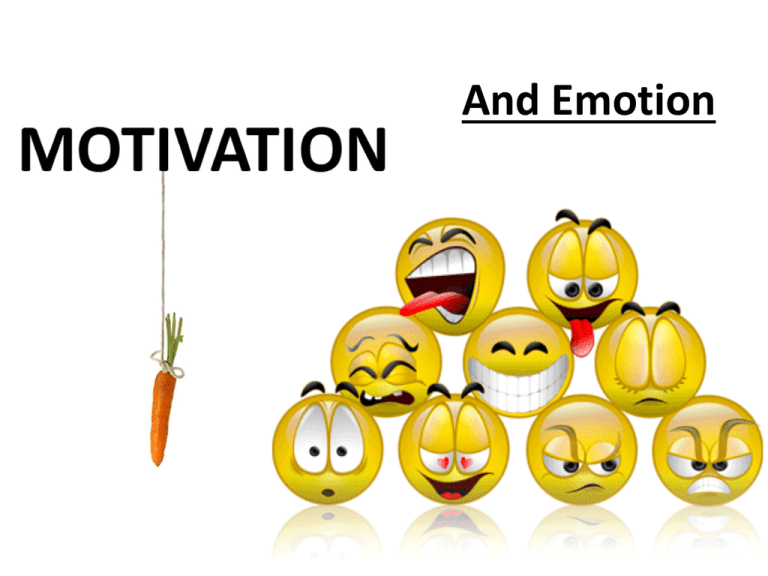
And Emotion Motivation: Wants, Desires and Needs Psychological drives that propel us What Is Motivation? • Factors that influence the initiation, direction, intensity, and persistence of behavior. • Cannot be directly observed, must be inferred. • Thought of as an intervening variable. Motivation • Motive are triggered by a stimulus (Incentive) – Bodily conditions (low blood sugar) – Cue in the environment (AP Test/College Success) – Emotion - Feeling, such as fear, joy, or surprise, that underlies behavior • When the stimulus creates goal-directed behavior it motivated the person About our the basketball shots… • Where would you predict that people with high versus low achievement motivation tend to stand with respect to the basket? • What might motivate one to stand very close to verses far from the basket? • What is gained or lost by standing at each position? • What might one learn about one’s abilities and skills after shooting the basketball from each position? • What does it mean to have a motivation for achievement? McClelland, 1955Achievement Motivation • Children who scored low on the need-forachievement test tended to take shots that the chances of success were virtually zero or so close that the chances were virtually 100%. • Children who scored high on the need-forachievement test tended to throw rings at moderate distances where chances for success were reasonable, but not guaranteed. Take the following survey… http://www.wwnorton.com/ college/psych/psychsci/media/surv ey.htm *Type “achievement motivation scale into Google) Motives as Intervening Variables Sources of Motivation • Biological Factors – Need for food, water, sex, temperature regulation • Emotional Factors – Panic, fear, anger, love, hatred • Cognitive Factors – Perceptions, beliefs, expectations • Social Factors – Reactions from others (parents, family, co-workers, peers, friends) What were YOUR Sources? Did you? Drink Water Eat something unhealthy East something healthy Put on clean underwear Get in a fight with family or a friend Drive faster than the speed limit or do something else dangerous while driving Study for a test/quiz Take a test/quiz without studying Do something exciting Source of Motivation (Biological, Emotional, Cognitive, or Social) What is the SOURCE of motivation? Most Powerful Motivators • Food and sex!! Theories of Motivation • • • • • Evolutionary Instinct Drive Reduction Arousal Theory Incentive Theory Maslow’s Hierarchy The Evolutionary Approach • Instinct- an unlearned biological pattern of behavior that is assumed to be universal throughout a species. • Meta-analysis during the height of this craze found 5759 ‘instincts’ • Sign Stimulus- something in the environment that turns on a fixed pattern of behavior. • What is an “instinct” that most infants have? • What would be the “sign stimulus?” Evolutionary Instinct Theory • Explains some animal behaviors •Explains some human behaviors •Does not explain other human behaviors Problems with Evolutionary Approach? • Most human behavior is far too complex to be explained on the basis of extinct. – Most important human behavior is learned – Human behavior is rarely inflexible and found throughout the species • Not adaptive for humans to have actions set in motion by a signal from the environment. • What capabilities do humans have that make the evolutionary approach less significant? Drive-Reduction Theory (Bodily Needs) When the instinct theory of motivation failed it was replaced by the drive-reduction theory. A physiological need creates an aroused tension state (a drive) that motivates an organism to satisfy the need (Hull, 1951). 17 Drive Reduction Theory • Motivation through DRIVE and NEED – Drive- Impulse to satisfy physiological need. – Need- Requirements of survival – Need for Food (PHYSIOLOGICAL) – Drive is Being Hungry (PSYCHOLOGICAL) Drive Reduction Theory • Some states are aversive (causing avoidance) – Hunger, thirst, sexual frustration • Satisfying drives is pleasurable • Homeostasis- The body’s tendency to maintain an equilibrium. • Primary and secondary (learned, i.e. $$$) drives As a DRIVE becomes stronger, we are motivated to REDUCE IT! Drive Reduction Theory Unbalanced Equilibrium Need (E.g. for water) Balance Restored Drive (E.g. thirst) Drive-Reducing Behaviors (E.g. drinking) Problems with Drive-Reduction? • Drive Reduction does not always explain motivation • People often behave in ways that increase rather than decrease a drive • Once homeostasis is achieved we’d never do anything Examples: • How is this true of diets? • Increasing Stress? Optimum Arousal Theory Human motivation aims to seek optimum levels of arousal, not to eliminate it. Young monkeys and children are known to explore the environment in the absence of a need-based drive. Harlow Primate Laboratory, University of Wisconsin Optimum Arousal Theory • Arousal- Feeling of being alert and engaged • Motivation influences arousal levels VS. Drives and Arousal • Yerkes-Dodson Law – Relationship between arousal and performance – Optimal point of arousal – Underaroused = bored – Overaroused = stressed Yerkes-Dodson Law 25 Intrinsic and Extrinsic Motivation • Intrinsic motivation – Motivation for a behavior is the behavior itself – Children playing is an example • Extrinsic motivation – Behavior is performed in order to obtain a reward or to avoid punishment – A bonus program is an example 26 Overlearning • Learning to perform a task so well that it becomes automatic. • With extra learning, when individuals are under conditions of high arousal, they can rely on automatic pilot to get things done. Incentive Theory • Incentives – stimuli that we are drawn to due to learning • We learn to associate some stimuli with rewards and others with punishment – we are motivated to seek the rewards What Motivates YOU? http://www.oprah.com/spirit/Howto-Determine-What-MotivatesYou-Motivation-Style
